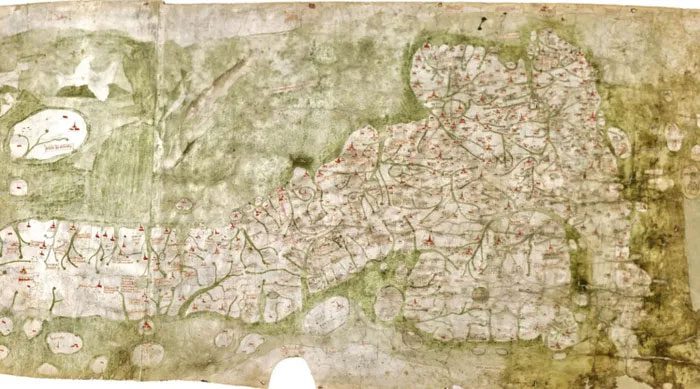The Kingdom of Cantre’r Gwaelod Disappeared in Wales is Believed to Have Sunk Beneath the Waves.
The Gough Map and the Ancient Kingdom of Cantre’r Gwaelod
For centuries, rumors have circulated about an ancient kingdom called Cantre’r Gwaelod that once existed in Cardigan Bay, Wales, before the land sank beneath the waves to become the foundation for a legendary “Atlantis of Wales”.
Stories of Cantre’r Gwaelod have changed over the years, with some claiming that a young girl neglected to prevent a well from overflowing the land, while later tales blame a drunken gatekeeper for failing to monitor the dikes.
It is said that the church bells of the submerged kingdom can still be heard on quiet evenings. Recently, two researchers have presented new evidence suggesting that two islands once existed in the bay, based on the analysis of medieval maps, folklore, field studies, and geological surveys.
Led by Simon Haslett, Emeritus Professor of Geophysics at Swansea University in Wales, this work has demonstrated that: “the existence of the missing islands is considered plausible and provides insight into the post-glacial coastal evolution of Cardigan Bay.”
“This study investigates historical sources, along with geological evidence and depth, and proposes a model of post-glacial coastal evolution, providing an explanation for the ‘lost’ islands and a hypothetical framework for future research,” Haslett and co-author David Willis Jesus, Professor of Celtic at the University of Oxford, wrote in the study.
“Literary evidence and cultural folklore suggest that Cardigan Bay is linked to the lost lowland of Cantre’r Gwaelod.”
This study is the first comprehensive investigation of the two mysterious islands depicted on the Gough Map, believed to date back to the 13th or 14th century, making it the oldest surviving map of the British Isles.
The land appears oval-shaped, located a few miles off the coast of Wales, with the southern part covering 7 square miles and the northern part twice that size, although Professor Haslett and Willis have cautioned that it is difficult to estimate accurately based on source materials.

The Gough Map. (Photo: VICE).
The Boundary Between History, Literature, and Tradition
The Roman geographer Ptolemy, who lived around 2,000 years ago, seemingly placed this stretch of the Welsh coastline about 8 miles deeper than it is today, suggesting that significant coastal erosion may have occurred in the subsequent centuries.
To build this possibility, Professor Haslett and Willis assessed the impact of glaciation on the area during the last Ice Age. As these glacial structures retreated over the past 10,000 years, they left behind a low-lying landscape comprised of soft sediments and deposits, shaped by geological forces such as rivers.
Interestingly, the locations of the mysterious islands on the Gough Map align with the underwater “sarns”, which are heaps of stones and gravel shaped by these forces. This suggests a possible origin story for the islands, as well as the demise of the islands when sea levels rose or perhaps due to a catastrophic flooding event like a tsunami or storm surge.
“In terms of measurement, the two islands described on the Gough Map appear to be closely aligned with Sarn Cynfelin, between the estuaries of the Ystwyth and Dyfi rivers, and Sarn y Bwch, between the estuaries of the Dyfi and Mawddach rivers, suggesting that the rough fragments of these ‘sarns’ may be anchored at the islands,” the research team announced.
“It seems that the erosion of the two islands was completed by the mid-16th century, as these islands do not appear on later maps, such as Thomas Butler’s Map of the Offshore Islands dated 1547 – 1554,” they added.
In an intriguing section of the study titled “Geomythology,” researchers shared a series of historical narratives, although they cautioned that: “care must be taken as the boundaries between history, literature, and tradition may have blurred.”
The researchers noted: “The story of Cantre’r Gwaelod may suggest that the lowland, or at least part of it, continued to be inhabited until the 5th – 6th century.”
Some authors have interpreted the legend of Cantre’r Gwaelod as representing a folk memory of landscapes gradually submerged due to rising sea levels over millennia since the last Ice Age.
“In Wales, the Mabinogi’s description of Bendigeidfran’s crossing to Ireland mentions only two navigable rivers lying in between… yet the sudden flooding of Cantre’r Gwaelod does not align with the explanation of rising sea levels for its collapse and instead evokes a quicker event or series of events,” they added, citing ancient tales of unexpected floods in the region.
Taken together, these findings provide an intriguing explanation for the strange islands depicted on the Gough Map, which may serve as evidence for this ancient land of Atlantis in Wales—and perhaps lead the way for the search for other submerged lands.





















































